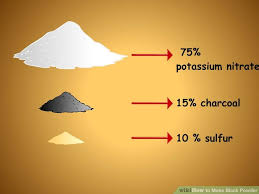Black (because of the smoke) gun powders consist of potassium nitrate (KNO3), charcoal and sulfur (S8), 75/15/10, or in sulfur -free version: KNO3/charcoal 82/18. Pulverized it burns slow. Finely ground in a ball mill it is extremely flammable and can be used as expelling charge in missiles and rockets and it lets just barely residue.
 Saltpeter (potassium nitrate, KNO3) was scarce and expensive, and was imported from India. The discovery that with birch wood ashes (potash) from urinary could be extracted potassium nitrate made it cheaper.
Saltpeter (potassium nitrate, KNO3) was scarce and expensive, and was imported from India. The discovery that with birch wood ashes (potash) from urinary could be extracted potassium nitrate made it cheaper.
The quality is improved by grinding it with water (and sometimes dextrin) much longer, and then drying and sieving. Gunpowder can only be wet milled by the combustion hazard. The ferocity of the combustion reaction depends on the mixing ratio and the particle shape and size. Charcoal of soft woods like willow is better.
Newer mixtures were ballistite with 10% camphor, 45% nitroglycerin and 45% collodion, and cordite of 58 mass percent nitroglycerin, 37% nitrocellulose and 5% petroleum jelly. They used acetone as a solvent and pressed it into spaghetti -like rods. Later this became 65% nitrocellulose, 30% nitrocellulose, and the 5% petrolatum (petroleum jelly).
Silver (and aluminum) does not spark and can still be used as metal when grinding or mixing gunpowder.
